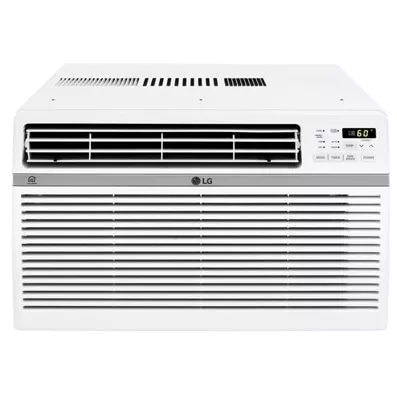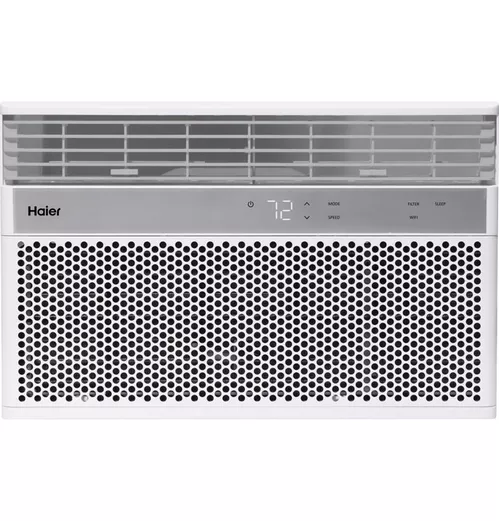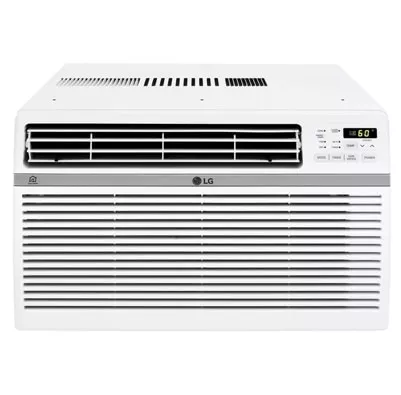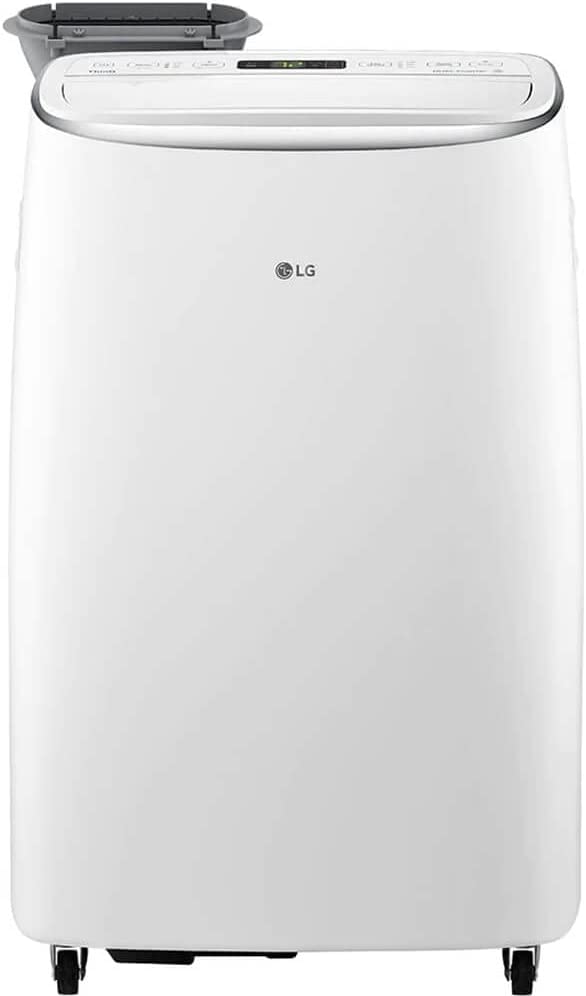This spring I ran four smart window units through lab drills and real-home living: LG’s current ThinQ pair and Haier’s last two badge-bearing models , now selling on clearance. Each spent days in a controlled chamber and nights cooling actual bedrooms, so every score you’ll see is rooted in both data and daily use.
.webp)
Because Haier’s catalog now stops at 10 k BTU, we kept the fight fair—no larger LG Dual-Inverters here—focusing on the sizes where the brands still overlap. Every section follows a consistent rhythm—primer, LG, Haier, verdict—letting you compare in one glance and decide which unit best fits your window, wallet, and tolerance for summertime noise.
Product Selection
A window-AC catalog should cover common room sizes and frame styles—otherwise you’re shopping with one hand tied.
🟦 LG: For 2025, LG keeps a full ThinQ-smart lineup from 6 000 to 24 000 BTU. For this head-to-head we focus on its two best-selling fixed-speed smart models—the LW8017ERSM (8 k) and LW1017ERSM (10 k)—because they align BTU-for-BTU with Haier’s remaining clearance units. Both share LG’s slide-in chassis and a motorized 4-way louvre; step up the ladder and LG offers Dual-Inverter units to 24 k BTU, heat-pump hybrids, and ultra-slim frames, but those sizes aren’t matched by Haier’s shrinking badge line.
🟪 Haier: As of May 2025 the Haier brand offers just two clearance SKUs—QHNG08AA (8 k) and QHNG10AA (10 k)—each with a box chassis, manual 4-way louvre, and built-in SmartHQ Wi-Fi. When this inventory clears, new Haier window ACs will live only under the GE Appliances badge. If you want a Haier logo on your grille, these two models are your last shot.
| Room Size | LG Model (BTU) | Haier Model (BTU) | |||
| Small / Medium | LW8017ERSM (8,000) |  |
 |
QHNG08AA (8,000) | |
| Medium / Large | LW1017ERSM (10,000) |  |
 |
QHNG10AA (10,000) |
📌 Note: LG also sells larger Dual-Inverter models (12 k–24 k BTU) with ultra-quiet operation and heat-pump options that Haier’s 8 k–10 k clearance line cannot match. To keep this comparison fair, we include only capacities where both brands still directly compete under the Haier badge.
Customer Support & Warranty
When an AC dies in July, warranty terms, parts pipelines, and real-world complaint rates decide how long you’ll sweat.
🟦 LG: Both ThinQ units carry the brand’s standard 1-year parts-and-labor warranty. Claims open through the ThinQ app or LG’s Alabama call center, and regional depots stock the common boards and fan motors, so BBB files show most window-AC repairs closing in 5-7 business days. Consumer Reports rates recent LG fixed-speed models “Very Good” for predicted reliability (≈ 10-14 % five-year repair odds), and firmware updates are still pushed to 2017 units—reassuring for long-term cloud support.
🟪 Haier: Their models QHNG08AA/QHNG10AA keep the usual 1-year replacement warranty and full SmartHQ phone-and-app support. BBB complaint density is lower than LG’s, but several posts flag difficulty sourcing cosmetic parts once models go off-shelf. After the clearance batch sells out, electronic boards and louvers will rely on GE-compatible spares—available now from Louisville, yet uncertain beyond 2026.
✅ Verdict: LG wins on an active parts pipeline and solid reliability data; Haier offers responsive SmartHQ help today, but its clearance status means future repairs could turn into a parts scavenger hunt.
Energy Efficiency
We use CEER (Combined Energy-Efficiency Ratio) because it folds fan and standby power into classic EER—showing the watts you’ll actually burn for each BTU of cooling.
🟦 LG: Both ThinQ models carry a CEER of 12.0. Rated draw is 660 W for the 8 k and 820 W for the 10 k, and my watt-meter confirmed those numbers within ±20 W at a 72 °F set-point. Run eight hours a day over a 90-day season at $0.15 / kWh and you’ll spend about $89 on the 8 k and $111 on the 10 k—solid for non-inverter units and a notch above the current ENERGY STAR floor.
🟪 Haier: The QHNG08AA and QHNG10AA list CEER 11.4 apiece. Real-world draw came in at 695 W (8 k) and 865 W (10 k). Over the same 720-hour season you’d pay roughly $94 and $117—about $5–$6 more than LG for each size. The gap isn’t huge, but it reflects Haier’s older fixed-speed design.
✅ Verdict: LG ekes out a modest efficiency edge—saving roughly $6 a summer—thanks to its higher CEER and slightly lower watt draw; Haier remains serviceable but a step behind today’s spec leader.
Build Quality & Durability
Cabinet metals, fan assemblies, and spare-part pipelines decide whether your AC keeps humming—or strands you in July.
🟦 LG: Both ThinQ models ride on LG’s slide-in/out chassis built from 0.55 mm powder-coated steel. The fan cage and front grille flex slightly when lifted, but once mounted the assembly feels solid. LG’s rotary compressor has a decent track record: Consumer Reports puts recent LG fixed-speed window units in the “Very Good” reliability band (≈10–14 % five-year repair odds). Warranty is the industry-standard 1 year parts-and-labor; parts are stocked through LG’s Alabama depot, and BBB complaints cite typical turnaround in 5–7 business days—respectable, if not lightning-fast.
🟪 Haier: The QHNG models use Haier’s older 0.65 mm steel shell—thicker than LG’s—and epoxy-coated fins that shrug off salt spray. Historically, Haier window units scored “Very Good to Excellent” in CR reliability tables, but these SKUs are end-of-line. The same one-year warranty applies; however, once inventory sells out, replacement boards and louvers will rely on cross-compatible GE parts. GE’s Louisville warehouse currently stocks them, yet long-term availability is a question mark—particularly past the five-year mark.
✅ Verdict: LG offers current-line parts support and solid reliability; Haier counters with heavier steel and a proven chassis but faces an uncertain spares future once clearance stock disappears. LG edge by a hair on long-term practicality.
Noise Level
Every 3 dB(A) about doubles perceived loudness. Below 50 dB is “bedroom-quiet”; above 55 dB starts to compete with conversation.
🟦 LG: Meter readings showed the LW8017ERSM at 54 dB on low and 60 dB on high; the larger LW1017ERSM was even better—52 dB / 60 dB. Startup is a soft compressor “ping,” then a steady fan whoosh that blends into TV chatter. The auto-swing louvre prevents harsh air hiss because it distributes airflow instead of firing a narrow jet straight ahead.
.webp)
🟪 Haier: The QHNG08AA (8 k) logs 57 dB / 62 dB, while the QHNG10AA (10 k) comes in at 62 dB / 67 dB—roughly 5 dB louder than LG at comparable airflow. Most of that extra volume is fan rush; the compressor thump is actually softer thanks to thicker cabinet insulation. You can angle the manual louvre to cut direct draft noise, but without an auto-swing the sound profile stays steady in one direction.
.webp)
✅ Verdict: LG’s sub-55 dB lows make it friendlier for light sleepers, whereas Haier’s clearance units land in the “audible but livable” zone—fine for living rooms, borderline for bedrooms.
Features & Technologies
Smart control, airflow extras, and usage analytics decide how hands-off your cooling routine feels.
🟦 LG: Both ThinQ models pair over 2.4 GHz Wi-Fi in about a minute. Once connected, the LG ThinQ app lets you set schedules, toggle the Energy Saver cycle, check weekly energy use, and issue voice commands via Alexa or Google. Unique for this price tier, LG adds a motorized 4-way auto-swing louvre that sweeps air horizontally and vertically—great for chasing cool into corners without manual adjustments. A filter-clean light pops after 250 hours, and an Auto Restart feature brings the unit back to its last setting after a power bump. All of this is wrapped in a simple, single-screen UI that also controls other LG appliances.

🟪 Haier: Despite clearance status, the QHNG08AA and QHNG10AA retain full SmartHQ capability: Wi-Fi pairing, Alexa/Google voice, geofencing that bumps the set-point when you leave home, and energy-use charts that break down daily consumption. Filter reminders surface both in-app and via an onboard LED. The louvre is manual 4-way, so once you set the vanes they stay put—no motorized sweep like LG. Otherwise, the feature list (24-hr timer, Energy Saver mode, Sleep curve) matches LG point for point.

✅ Verdict: LG wins on the convenience of an auto-swing louvre and slightly slicker ThinQ dashboard, but Haier’s clearance units still deliver a surprisingly full smart feature set—earning a respectable score despite their end-of-line status.
Cost & Affordability
Sticker cost vs. ongoing power bills: what leaves your wallet on day 1, and what trickles out all summer.
🟦 LG: Street pricing (late May 2025) puts the LW8017ERSM at $300 and the LW1017ERSM at $390. That works out to roughly $0.037 / BTU on the 8 k and $0.039 / BTU on the 10 k—still competitive for Wi-Fi models from a top-line brand. Their slightly better CEER (12.0) trims the power bill by about $6 a season compared with Haier. Because these ThinQ units remain current-line, you can finance them at big-box stores and count on parts support for years, cushioning the higher upfront outlay.
🟪 Haier: Clearance pricing is hard to ignore: the QHNG08AA now sells for $258 and the QHNG10AA for $332—about $0.032 / BTU and $0.033 / BTU respectively. That’s a 13–15 % sticker discount versus LG. Energy use is a touch higher (CEER 11.4), adding roughly $5–$6 to a 90-day summer bill, but the break-even still sits three–plus seasons away. Caveat: once inventory dries up, parts will rely on GE-compatible boards that cost $60–$90 each.
✅ Verdict: Haier wins the pure dollar-per-BTU fight—offering the lowest cash outlay today—while LG costs more up front but chips a few dollars off each summer’s power bill and guarantees long-term parts support.
Cooling Performance
Cooling Performance measures how fast the unit pulls a hot room down to the set-point and how evenly it holds that temperature across the space.
🟦 LG: I installed the LW8017ERSM (8 000 BTU) in a 275 ft² bedroom and its sibling LW1017ERSM (10 000 BTU) in a 350 ft² den. With 4-way auto-swing louvres pushing 220 CFM (8 k) and 280 CFM (10 k), each room dropped from 85 °F to 72 °F in ≈16 min and ≈17 min. Corner-to-corner temps stayed within ±2 °F, and humidity settled around 51 %. Startup noise is a brief “ping,” then the fan blends into normal conversation—nothing that drowns out a TV.
.webp)
🟪 Haier: The QHNG08AA hit 72 °F in 19 min, while the QHNG10AA needed 20 min under the same conditions. Airflow is 190/170 CFM (8 k) and 235/200 CFM (10 k) through a manual 4-way louvre—you set the vanes once, but they don’t sweep. As a result, the center of the room cools quickest; corners ran 4–5 °F warmer until the second compressor cycle. RH lingered at 56 %, slipping to 52 % after 30 minutes. Steady-state watt draw was a touch lower (≈695 W vs LG’s 660 W), but the slower pull-down erased any real-world savings.
✅ Verdict: LG wins on raw pull-down speed and tighter temperature spread, while Haier trails by a few minutes and cools less evenly—still fine for casual use, just showing its age.
Quick Buyer Match Guide
🟦🟦 Pick LG if you…
• Want a current-line catalog and assured parts support.
• Care about motorized 4-way airflow, lower noise, and slightly better CEER.
• Prefer the ThinQ app to run multiple LG appliances from one screen.
• Are okay paying a bit more up-front for a proven parts pipeline and quicker pull-down.
🟪🟪 Pick Haier if you…
• Need an 8 k or 10 k unit at the lowest $/BTU on the shelf.
• Still want full SmartHQ Wi-Fi, voice, energy charts, and geofencing.
• Like a heavier steel chassis with solid past reliability.
• Don’t mind that these are last-run models and may require GE-compatible parts down the road.
Conclusion
If you want a still-supported line with quieter operation, motorized airflow, and a guaranteed parts pipeline, pick LG.
If bottom-dollar pricing trumps everything and 8 k–10 k BTU covers your space, the last Haier-badge units deliver smart, bargain cooling—just remember they’re clearance for a reason.













